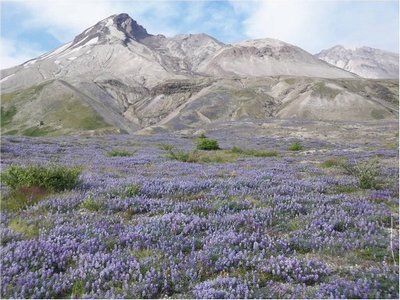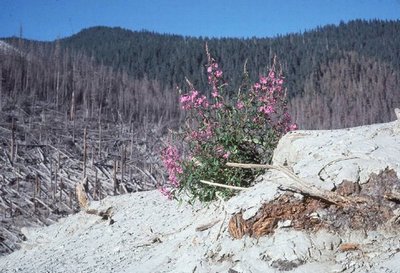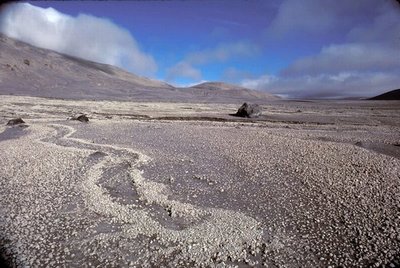May 3, 2010
Experts list: Lessons from Mount St. Helens being applied today
May 18 marks the 30th anniversary of the eruption of Mount St. Helens and scientists to this day use what’s being learned there to challenge established thinking about how landscapes evolve and rebound — even from something so bleak that University of Washington biologist John Edwards, who visited St. Helens within weeks of the eruption, said, “The sky was overcast, gray and everywhere you looked was gray. It felt like your color vision had been turned off.”
And what is being learned at Mount St. Helens helps us better understand such things as the behavior of the ash cloud that spewed out of the volcano beneath the Eyjafjallajokull glacier in Iceland.
Most recently published paper concerns importance of transitional ecosystems
Just out March 2 in “Frontiers in Ecology and Environment” is a review of the underappreciated value of ecosystems that develop between the time trees are removed — by natural processes such as eruptions or fires, or by harvesting — and when they again dominate. These so-called “early-successional” forest ecosystems attract and sustain numerous species and are characterized by highly productive plant species that thrive without a tree canopy above, according to authors who include Jerry Franklin, professor of forest resources, and first-author Mark Swanson, a recent UW graduate, now on Washington State University faculty.
Jerry Franklin
Professor of forest resources
206-685-0954 (assistant Lynne Hendrix)
jff@uw.edu
Faculty website: http://faculty.washington.edu/jff/
Key findings: Important theoretical and management implications are continuing to emerge from Mount St. Helens research. An early epiphany had to do with the important roles played by biological legacies (organisms and structures, such as snags and logs) that survive and contribute to post-disturbance ecosystems. Management implications have been huge, for example, resulting in the development of retention harvesting as an alternative to clearcutting and reconsideration of salvage logging on federal forest lands after wildfires or other disturbances.
Mark Swanson
Doctorate in forest resources from UW; WSU assistant professor of natural resources
206-947-5323 (cell)
markswanson@wsu.edu
Faculty website: http://www.natural-resources.wsu.edu/people/faculty/swanson.html
Key findings: In a very real way, we are not starting “from scratch.” Even after an eruption, the ecosystem inherits many values and functions from pre-disturbance elements. Also, a large disturbance like the 1980 eruption of Mount St. Helens creates diversity at scales from very small (snowbank communities and hummock communities) to very large (the blast zone is a naturally disturbed area in the primarily forested West Cascades).
30 years of mainly happenstance, succession slowly becomes more predictable
The relationship between vegetation and environment was initially random then, over time, environmental effects such as moisture and soil conditions began to play more of a role. Such “deterministic” processes, as opposed to happenstance, are just now being observed at Mount St. Helens and are the subject of papers in early 2010 and late last year in the Journal of Vegetation Science. It’s not just about understanding nature: “Understanding how communities assemble should allow greater success in restoring vegetation after devastating impacts,” says UW professor Roger del Moral, lead author.
Roger del Moral
Professor of biology
206-543-6341
moral@uw.edu
Faculty website: http://faculty.washington.edu/moral
Key findings: Along with the role of chance, del Moral found that distance is important in determining which species arrive on a site. In cases where regeneration depends on spontaneous regeneration, the communities that result may not be fully functional. Also, successional development is governed by a functional clock, not by the calendar. Thus, of two sites that are similar except being at different elevations, the higher elevation site will be colder and develop more slowly than the lower, warmer, site. del Moral has published more than 120 peer-reviewed papers in his career, of which 62 related to Mount St. Helens and primary succession on volcanoes.
St. Helens informs understanding of volcanoes today
Olivier Bachmann
Assistant professor of Earth and space sciences
206-543-7615
bachmano@uw.edu
Faculty website: http://faculty.washington.edu/bachmano/HomePage/Welcome.html
Key findings: The dispersion of the ash plume from Mount St. Helens was well studied and helps constrain models of ash dispersion in the atmosphere after explosive eruptions, such as the one in Iceland. Another significant observation made during the eruption of Mount St. Helens was that lateral blasts are common and can happen without much warning at arc volcanoes. It also allowed volcanologists to monitor a reawakening volcano with modern tools for the first time, and gave us insight on what kind of precursory signals we can expect before large Plinian eruptions, those marked by columns of gas and volcanic ash extending high into the atmosphere. There has been a lot of work since Mount St. Helens on topics such as shapes of shallow magma chambers, magma evolution and residence time in the crust, as well as lava dome growth.
Steve Malone
Professor emeritus of Earth and space sciences
206-685-3811 (office)
steve@ess.washington.edu
Faculty website: http://earthweb.ess.washington.edu/malone/
Key findings: Scientists have become better at anticipating the beginning of eruptions at quiet volcanoes. There were obvious precursors to the Eyjafjallajokull eruption, thus its beginning was anticipated by the Icelandic volcanologists. What we can’t do well at all is anticipate when an eruption will stop, which is of greatest interest now in Iceland. Also from Mount St. Helens we’ve learned a lot about the nature of the small volcanic earthquakes that occur before and during dome building eruptions. Their character can tell us something about the conduit through which the molten rock is moving and give hints about when and what type of eruption may be coming.
Effects not uniform
Tom Hinckley
Professor of forest resources
206-685-1928 (office)
hinckley@uw.edu
Faculty website: http://www.cfr.washington.edu/SFRPublic/People/facultyProfile.aspx?PID=9
Key findings: Hinckley and his students have studied how different species, stand compositions and ages affected the recovery of trees that were covered with ash. While young trees recovered in as little as two seasons, old-growth silver firs underwent extensive decline, dieback and mortality. Silver firs have stiff needles and rigid branches that held onto the ash, reducing the amount of sunlight that reaches their needles and making them less vigorous. He’s also looked at how snow and erosion have shaped recovery in the blast zone. For example, many very small, but surprisingly old, mountain hemlock and silver fir trees were covered in snow when the eruption occurred. Those trees survived and today they form stands over 30 feet (10 meters) tall with many of the trees producing seed for the last several years.
“It’s raining spiders!”
Rod Crawford
Curator of arachnids, UW Burke Museum of Natural History and Culture
206-543-9853 (Crawford is in his office most days, 5:30 p.m. to 3 a.m.)
tiso@u.washington.edu
Website: http://staff.washington.edu/tiso/
Key findings: Mount St. Helens gave scientists the first quantitative information on aerial dispersal of spiders. We always knew spiders dispersed by air but had no idea of the magnitude. A succinct way to put it would be, “It’s raining spiders!” See “Spider Arrival and Primary Establishment on Terrain Depopulated by Volcanic Eruption at Mount St. Helens, Washington,” American Midland Naturalist.
“Like sandpapering an insect to death”
John Edwards
Professor emeritus of biology
206-525-4137 (home)
Key findings: The initial ash from Mount St. Helens was lethal to many insects. It stripped away the waterproofing layer, insects lost moisture and quickly died. “It was like sandpapering an insect to death,” Edwards says. But as the ash became less gritty, predatory beetles, ballooning spiders and other bugs began to arrive. It was calculated that 1,500 insect species were carried by winds into the blast zone from the surrounding forest and farmlands. Even those that didn’t survive had a role in the rebirth of the site, becoming food or compost. “One could say many of the first seeds germinated in bug compost,” he says.
###
US Geological Survey images:
http://vulcan.wr.usgs.gov/Volcanoes/MSH/Images/framework.html



